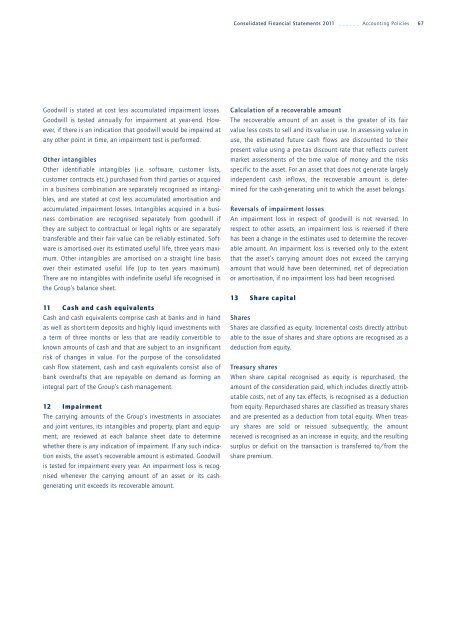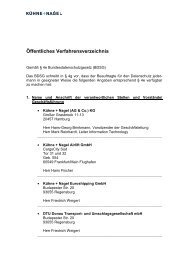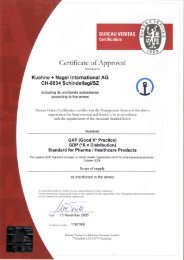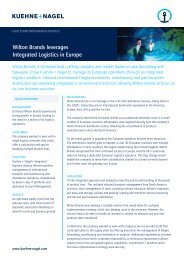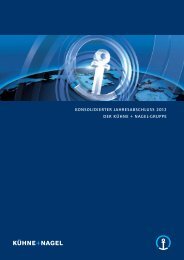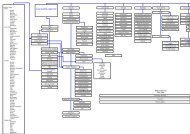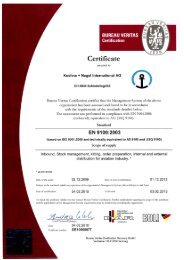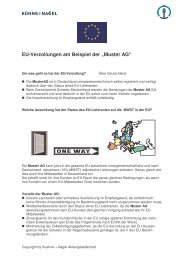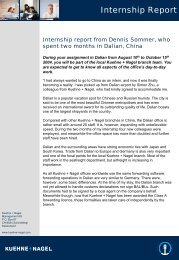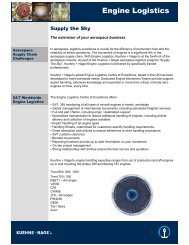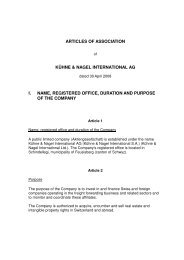ANNUAL REPORT 2011 - Kuehne + Nagel
ANNUAL REPORT 2011 - Kuehne + Nagel
ANNUAL REPORT 2011 - Kuehne + Nagel
Create successful ePaper yourself
Turn your PDF publications into a flip-book with our unique Google optimized e-Paper software.
Goodwill is stated at cost less accumulated impairment losses.<br />
Goodwill is tested annually for impairment at year-end. However,<br />
if there is an indication that goodwill would be impaired at<br />
any other point in time, an impairment test is performed.<br />
Other intangibles<br />
Other identifiable intangibles (i.e. software, customer lists,<br />
customer contracts etc.) purchased from third parties or acquired<br />
in a business combination are separately recognised as intangibles,<br />
and are stated at cost less accumulated amortisation and<br />
accumulated impairment losses. Intangibles acquired in a business<br />
combination are recognised separately from goodwill if<br />
they are subject to contractual or legal rights or are separately<br />
transferable and their fair value can be reliably estimated. Software<br />
is amortised over its estimated useful life, three years maximum.<br />
Other intangibles are amortised on a straight line basis<br />
over their estimated useful life (up to ten years maximum).<br />
There are no intangibles with indefinite useful life recognised in<br />
the Group’s balance sheet.<br />
11 Cash and cash equivalents<br />
Cash and cash equivalents comprise cash at banks and in hand<br />
as well as short-term deposits and highly liquid investments with<br />
a term of three months or less that are readily convertible to<br />
known amounts of cash and that are subject to an insignificant<br />
risk of changes in value. For the purpose of the consolidated<br />
cash flow statement, cash and cash equivalents consist also of<br />
bank overdrafts that are repayable on demand as forming an<br />
integral part of the Group’s cash management.<br />
12 Impairment<br />
The carrying amounts of the Group’s investments in associates<br />
and joint ventures, its intangibles and property, plant and equipment,<br />
are reviewed at each balance sheet date to determine<br />
whether there is any indication of impairment. If any such indication<br />
exists, the asset’s recoverable amount is estimated. Goodwill<br />
is tested for impairment every year. An impairment loss is recognised<br />
whenever the carrying amount of an asset or its cashgenerating<br />
unit exceeds its recoverable amount.<br />
Consolidated Financial Statements <strong>2011</strong> _ _ _ _ _ _ Accounting Policies<br />
Calculation of a recoverable amount<br />
The recoverable amount of an asset is the greater of its fair<br />
value less costs to sell and its value in use. In assessing value in<br />
use, the estimated future cash flows are discounted to their<br />
present value using a pre-tax discount rate that reflects current<br />
market assessments of the time value of money and the risks<br />
specific to the asset. For an asset that does not generate largely<br />
independent cash inflows, the recoverable amount is determined<br />
for the cash-generating unit to which the asset belongs.<br />
Reversals of impairment losses<br />
An impairment loss in respect of goodwill is not reversed. In<br />
respect to other assets, an impairment loss is reversed if there<br />
has been a change in the estimates used to determine the recoverable<br />
amount. An impairment loss is reversed only to the extent<br />
that the asset’s carrying amount does not exceed the carrying<br />
amount that would have been determined, net of depreciation<br />
or amortisation, if no impairment loss had been recognised.<br />
13 Share capital<br />
Shares<br />
Shares are classified as equity. Incremental costs directly attributable<br />
to the issue of shares and share options are recognised as a<br />
deduction from equity.<br />
Treasury shares<br />
When share capital recognised as equity is repurchased, the<br />
amount of the consideration paid, which includes directly attributable<br />
costs, net of any tax effects, is recognised as a deduction<br />
from equity. Repurchased shares are classified as treasury shares<br />
and are presented as a deduction from total equity. When treasury<br />
shares are sold or reissued subsequently, the amount<br />
received is recognised as an increase in equity, and the resulting<br />
surplus or deficit on the transaction is transferred to/from the<br />
share premium.<br />
67


